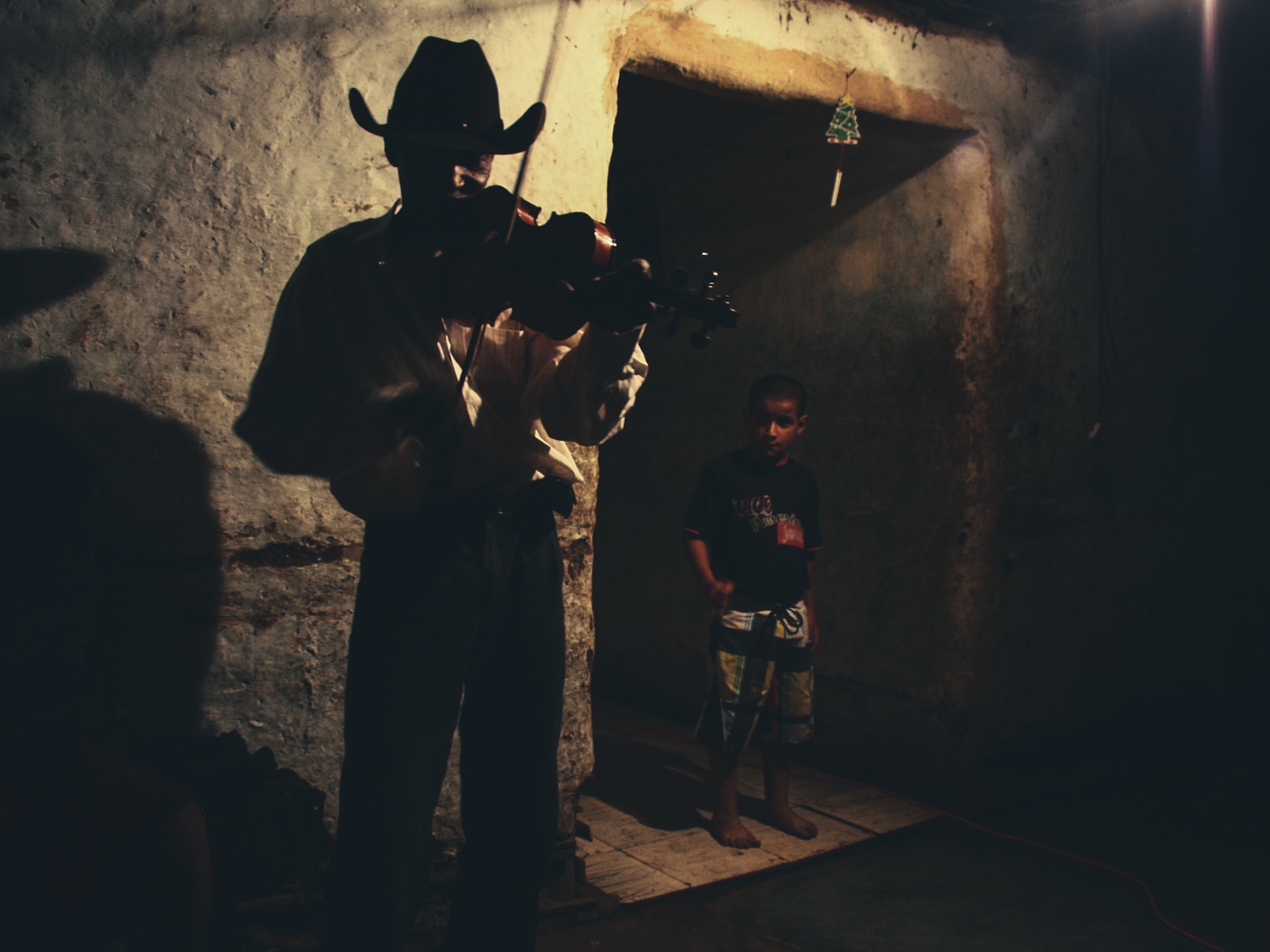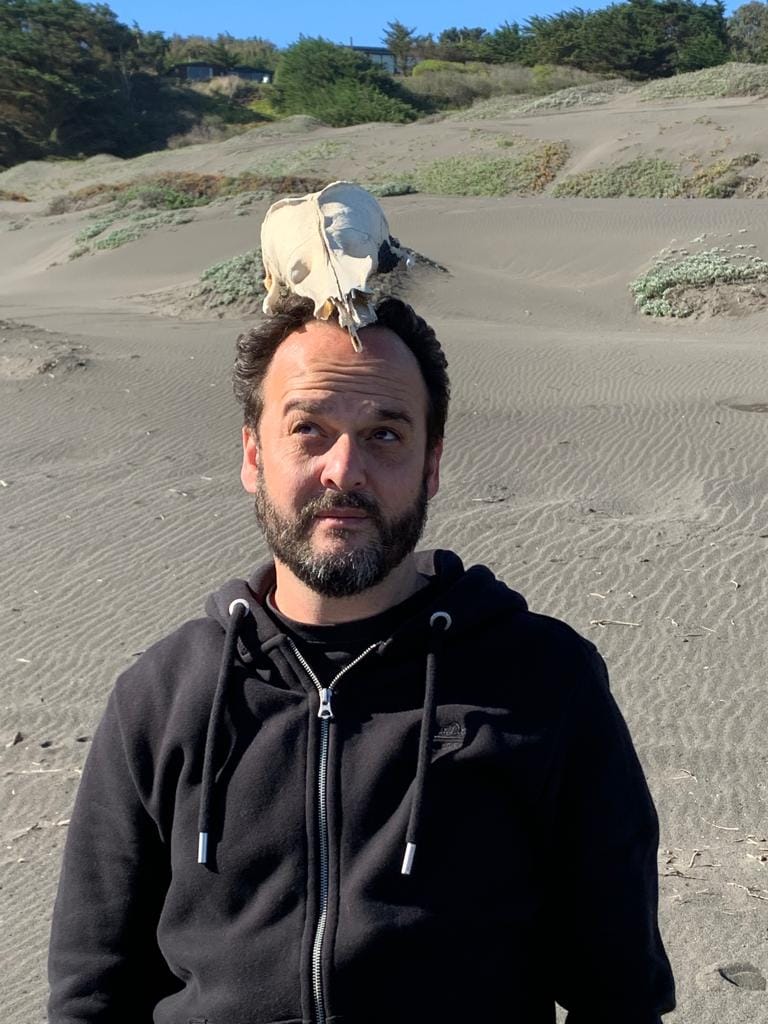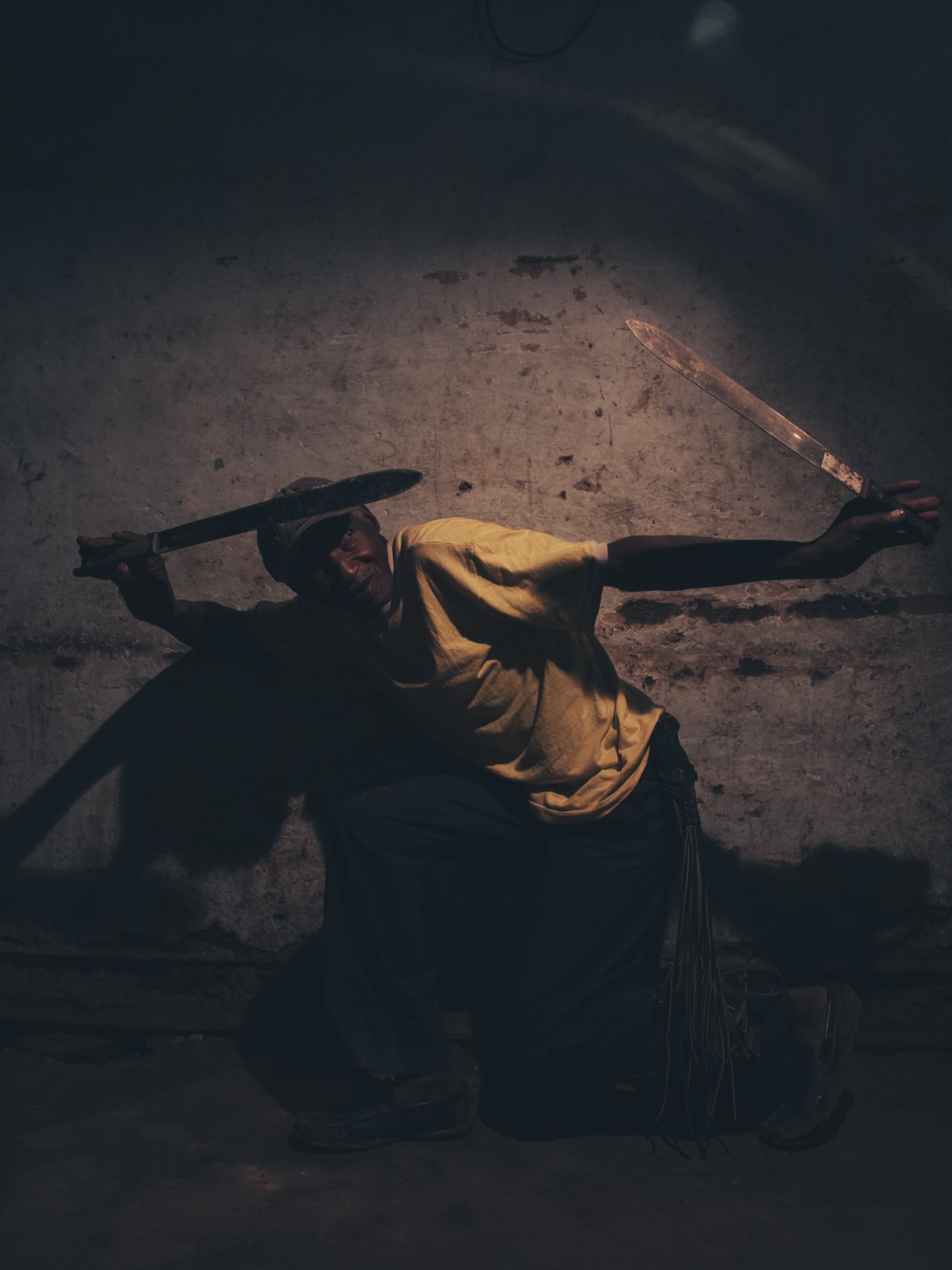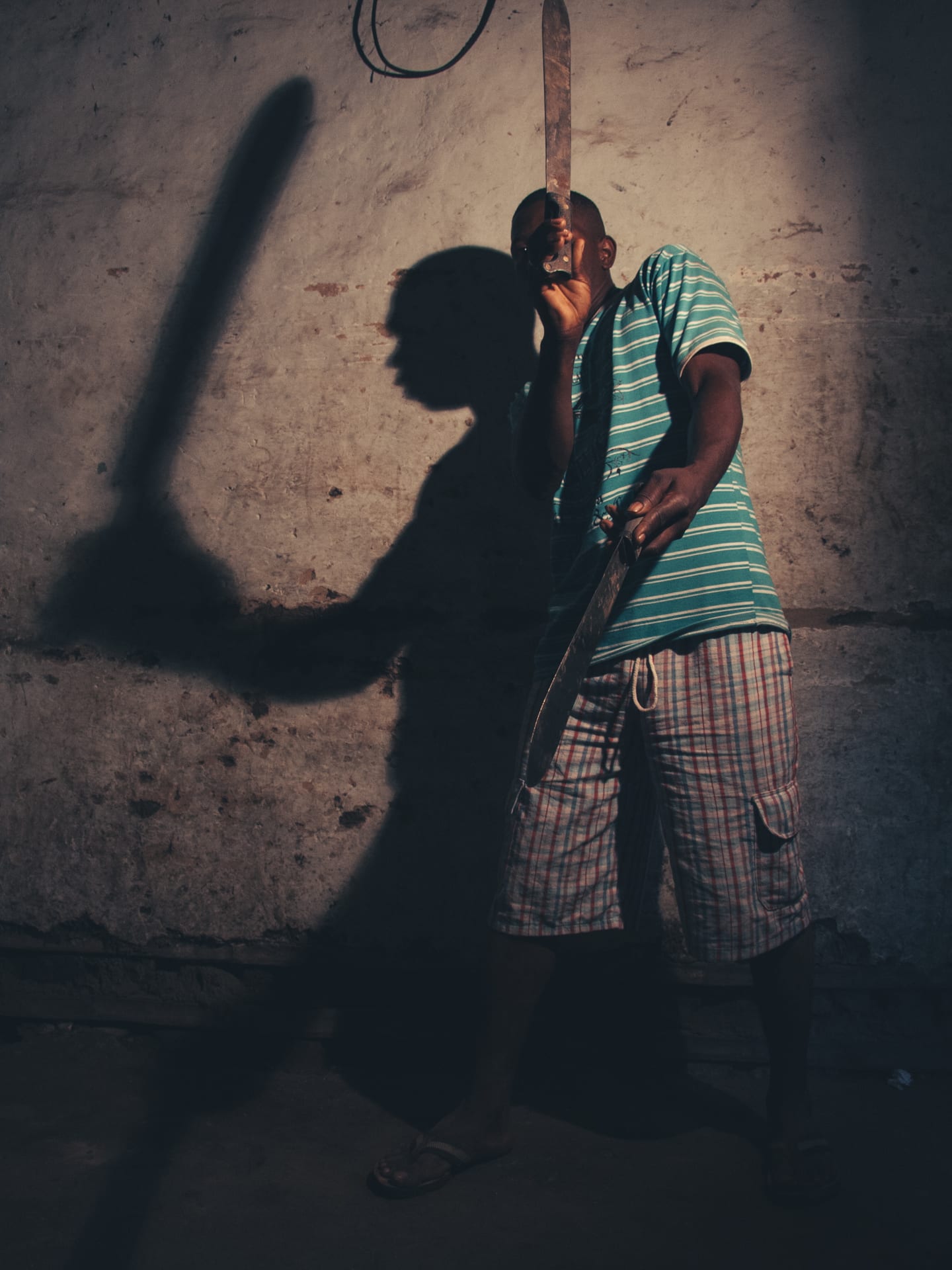
Fictions for imagining flavorful futures
The literature of the Colombian writer Juan Cárdenas serves as a reference for connecting seemingly dissimilar issues: the academic with the popular, such as literary theory and machete fencing. In this interview, we explore his two latest novels, “Peregrino Transparente” and “Elástico de Sombra,” to reflect on how art, as a political tool, compels us to preserve the memory of people and, at the same time, imagine multiple possibilities for the future.
By Marcela Vallejo
Photos by Jorge Panchoaga
Whenever I finish Juan Cárdenas’ books, I always have the same feeling: that I didn’t fully understand something or missed something. But I also traveled to familiar places, although I’m not entirely sure. His stories are intense; there are almost always journeys, powerful images, and lingering ideas.
I don’t forget, for instance, what the protagonist of “Los Estratos” thinks about the Swinglea, or “Limón de Cerca,” the plant used in several places to cover grilles when he says it’s to make confinement seem more natural. I don’t forget the very familiar feeling of those labyrinthine journeys in “El Diablo de las Provincias” because that tiny city is Popayán for me (where Juan Cárdenas was also born), and there you don’t always know where you’ll end up when you go out into the street.
Cárdenas lived outside of Colombia for several years and returned to understand some of his creative impulses and be close to the stories that accompany and intersect with him. This year, he published “Peregrino transparente,” a book described as “monstrous, insane, beautiful,” as Victor Albarracín said in a presentation. It’s a novel that appears to be an essay that experiments with forms and draws inspiration from Manuel Ancízar’s “The Pilgrimage of Alpha” (written during the first journey of the Corographic Commission). Still, it creates a Western, as Cárdenas states at the beginning of the book.
The character (narrator, author, we’re not exactly sure) announces that it’s an exercise to “guess the present.” It’s not a historical novel; it’s a journey into the past to understand the present, to imagine a “flavorful future.”
This book is related to Cárdenas’ previous novel, “Elástico de Sombra,” in which he travels with Macheteros (Machete Wielders) from the north of Cauca through their fantastical tales and the stories accompanying them. Witches, goblins, little devils, and fantastic beings, much like the Macheteros themselves, are audacious beings performing machete feats, making deals with the devil, pondering the character of the wind, Don Viento. The connection begins with the form, he says, because in these novels, unlike the previous ones, the characters and places have names. But it goes further: the 19th century, the marvelous characters of this region of the country, the interest in understanding a knowledge that involves flavor.
“What interests me is the futuristic nature of these things,” Cárdenas will tell me to make clear what he seeks with his literature, with the images he constructs with words. “These are not fictions to peek into a remote past, but to invite people to desire to create cooler, more flavorful, more awesome, more beautiful, and more celebratory futures of forces that are there. There’s something that moves us deeply and has been around for a long time, but it’s propelling us forward.”

Your two latest books, “Peregrino Transparente” (2023) and “Elástico de Sombra” (2019), are very different from your previous works, and they are also different from each other. I understand that both stem from research processes. Why is there such a difference from your previous books, and what was the writing process for these texts like?
Indeed, these books are quite different from what I had been doing. For example, a detail may seem minor but is quite structural. If you look at my previous books, there are no proper names: people don’t have names, streets don’t have names, cities don’t have names, nothing has a name. And suddenly, in these two books, there are not only names but many of them. This seemingly cosmetic or superficial difference is, in fact, a significant structural change because the politics of proper names is at play in both cases. The absence of proper names in my previous books was part of a broader politics of naming, and it’s connected to a very different approach to the territory.
In the case of my earlier texts, I felt the need to create distance and disorientation. While reading, I wanted the reader to ask, “Where is this? Where is it taking place?” But simultaneously, the descriptions are so meticulous, and everything is constructed so that you start to get into the groove and think, “Well, this is like the Colombian Pacific.”
When I finished that cycle of novels with “El Diablo de las Pprovincias,” I wasn’t sure what to do next, but I had a few things in mind. One of them was my research on machete fencing. I had been visiting the masters and working on more academic research for about six years. During that time, my relationship with Master Sandoval and Miguel Lourido had evolved, and I had become more than just the white academic; we had become friends. It was like the ethnographic pact had been broken.
At one point, they told me these academic products weren’t serving anyone. They said, “You’re a writer, write something.” So, we discussed it, and the process was enjoyable because we imagined together what it would be like. We thought about a movie, a documentary. But what impressed me a lot was the fantastic stories – these guys had a technical side, like how to move, make a certain movement, etc. But then, I realized that behind all the martial arts aspects was folklore, a wealth of folkloric and fantastic stories about Macheteros performing feats doing magical and wild things. And I loved that.
I think they envisioned it as something very Kung Fu; they wanted it to be like a martial arts novel. Ultimately, I think it turned out to be something in between. But it made no sense to write this book using the techniques I had used for my previous works; there had to be names, and people had to be called something. So, the politics of proper names changed, and interestingly, that profoundly affected everything that came after writing “Peregrino” as well.
I suddenly reconciled with the idea of using these proper names and using them in a certain way. Proper names are dangerous; when you say Buenaventura, Cali, Popayán, or Pasto, there are many associations and preconceptions. That is precisely what “Peregrino” is about – how these regional imaginaries and prejudices were constructed.


“It is an attempt to reconstruct the fabrics of a series of regional histories, which I believe we do not owe to ourselves because they are the stories of our grandparents because they were lost. We must recognize these things we should tell ourselves because this is our political and biographical legacy. It has to do with what we treasure.”
Another difference, especially with ‘Peregrino,’ is how it approaches time. The previous ones narrate stories in the present or a more recent and identifiable time, but ‘Peregrino’ delves into the past. Both connect to the 19th century; ‘Peregrino’ is set in the 19th century, but the Macheteros are strongly linked. Why so much interest in that century?
Interestingly, I arrived at the 19th century through the Macheteros because it was the period of the peak of machete fencing, the zenith of its practice. Many people were practicing machete fencing, especially the black armies of 19th-century liberalism, which fought in all the wars from the War of Los Supremos to 1870, which was the most potent period. These were contingents of hundreds of men skilled in machete fencing.
It was peculiar because, in the process of researching, studying, reading, and collecting oral stories about machete fencing, everything somehow led to the 19th century. That century it marked an era of invention, such as the idea of democracy, where the participation of numerous subaltern sectors, not only blacks but all the subaltern sectors in the Great Cauca, played a tremendous role.
So, I gradually encountered this universe of people, the ordinary folks who have always constructed the images, mythology, and ideas upon which our thoughts about Cauca, the Greater Cauca, or this entire region as a historical and political battleground are based. Ultimately, all of this is connected with an underlying autobiographical aspect that never appears very clearly in any of the texts but is always there. It has always been a lovely mystery to think about the people I ultimately came from: my family and the common folks. They are like threads that connect everything. In other words, this entire narrative of craftsmanship is intimately linked to the narrative of the black armies in Northern Cauca, as well as figures like the ñapangas and the figures of the small stores.
It’s an attempt to reconstruct the fabric of a series of regional stories, which I believe we owe to ourselves because they are the stories of our grandparents, as they have been lost. I needed to acknowledge these things we should tell ourselves, as this is our political and biographical legacy. It has to do with what we treasure.
I was thinking again about that relationship with the present because right at the beginning of ‘Peregrino,’ there’s a reflection on history, on the apparent inevitability of history; this made me think of the researcher Ariella Azoulay when she says that the way history is told makes it seem like what happened was inevitable, like a destiny. But when one starts to see, there are more possibilities in reality. This leads me to think about the relationship with the present; it’s not just about traveling there and seeing what happened – avoiding historical fiction, of course – but about reconstructing the other narratives you mentioned. However, it’s challenging not to reconstruct these narratives without falling into a representation that reproduces the illusion of historical destiny.
Yes, but precisely, I believe that’s why the novels are constructed this way in both cases. Of course, by saying this, I’m not suggesting that I avoided the problem; no. But there was an awareness that we needed to avoid that issue, meaning the idea of a single and official narrative. In ‘Peregrino,’ right from the start, I say, “This thing is coming to me while I look out the window,” in other words, I’m telling you that it’s occurring to me, I’m putting you in front of the fact that it’s a fantasy.
It’s important to emphasize this because it has much to do with what you mentioned about Ariella Azoulay. I’m very interested in how she thinks about the archive. You don’t create the archive to construct an official history; you build the archive as a public space, and in every public space, there are projections, fantasies, imaginaries, and desires as well. And desires are always projectiles; they move toward the future, and they are thrown forward. So, I’m more interested in the futuristic dimension of the archive than in the dimension of truth.
I think it’s cool to reconstruct these oral history narratives, often by filling gaps because the documents are insufficient, not even the oral testimonies or anything; you have to fill in the gaps, you have to engage in an exercise of imagination, a literary exercise, deduction, and invention.
In these two books, there’s a narrator or a character who is you but not you. To what extent can it be said that you appear there? I’m thinking about the distance between the author and the narrator, and at the same time, about the first person who speaks to the readers in ‘Peregrino,’ and also about the character Cero in ‘Elástico de Sombra.’
First, I believe this issue is almost impossible to resolve. You probably know that these debates about the author’s place, who the narrator is, and who the biographical person is have been endlessly discussed. It will always be there and difficult to define, if not impossible.
It’s interesting to think that authorship has primarily a legal origin in the Middle Ages. When you sign a text, when that name appears at the bottom, it means that this is the legal responsibility for what is said there. In other words, you sign it, and they can burn you alive. That happened in the Middle Ages, but it still happens today. The concept of authorship has a legal origin, and that’s still there; you always make yourself responsible by putting in your signature.
We had an interesting debate when we were talking to Miguel. We both sign many of the academic products we created because we do the research. But with the novel, we said, “Well, I’ll write the novel, but should we sign it together, create a pseudonym, or what should we do?” We considered all these options, but Miguel said, “If we sign with a pseudonym, everyone will think it’s so-and-so’s novel, and no one will care. On the other hand, if you sign it, it’s your name; you already have a name, and that name is what will make people read the book.”
In the end, there’s always a condition of phantasmagoria. The “I” is what dissolves the most and becomes a very strange specter that’s there. In my case, I’m pulling on threads, on narratives, and curiously, there’s an autobiographical tension in the background. It’s like, who am I, and why am I drawn to these things.
“Yes, one is taking pictures, making installations, or doing some specific praxis that implies that I spent much time alone, thinking. But in reality, one is doing these things with and for others. Images and texts can build a community that other forms don’t have. The text becomes that public space where people discuss it.”
When we talk about memory, we often talk about something that can be verified, recorded, or concealed, but it’s not always the case. The truth is that memories are continually being constructed. I think about what we’ve discussed and what Azoulay says, and it leads me to think that one of the ways to escape from these seemingly inevitable stories is imagination. I heard an interview where Malena Rey mentioned that you are an author with great confidence in imagination. What are your thoughts on that assertion, and how do you approach the relationship between memory and imagination?
I have an ambiguous or complicated relationship with imagination because, on the one hand, I don’t like the idea of unbridled fantasy just for the sake of it. This idea comes from surrealism, certain avant-garde in the realm of total fantasy. I always feel uneasy about the idea of imagination as a purely lavish and sportive expenditure of fantasy. Because I also believe in scientific methods and am interested in them. Whenever someone mentions the word “imagination,” I remember a quote from Reichel Dolmatoff in an ethnography he wrote about the Tucano people in Vaupés.
He says an incredible thing about how the Tucano people conceive their metaphysics. They have a whole set of words where, for example, there is an etymological affinity between the terms used for light and semen, so there’s a full idea of generation in light.
Reichel continues along that line of thought, and when he concludes, he says, “For the Tucano people, imagination is a tool of high precision.” I’ll never forget that phrase because if an idea of imagination needs to be defended, it’s that one. You’ve exhausted all possible rational avenues, employed all your techniques, resources, procedures, and discourses in the service of an inquiry, and suddenly, you’re left with many gaps you can’t fill. Well, imagination fills those gaps, and it has to be of the utmost precision.
That’s the type of imagination I believe in. In these places where there’s so much impunity and where we have this history that is challenging to reconstruct – how we’ve been oppressed, destroyed, and persecuted – it’s often difficult to do so because our enemies deliberately erase traces and obscure the narratives. That’s where imagination has to come in.
You reach a point where you say, “Okay, I don’t have the testimony, the evidence, strong pieces of evidence to establish a material connection. But I have some small ruins, some small clues, and from these clues, I will try to use my imagination as that tool of high precision to reconstruct the narrative so that it doesn’t go unpunished so that we can tell this story, share it, and create narratives.”
Why is it so important to create these narratives?
When you start getting interested in literary theory and delve into all the debates of the 1960s, especially French theory, you inevitably end up in the discussions surrounding a magazine called “Tel Quel,” in which many writers and thinkers emerged. In that magazine, there was an almost universally shared dogma among those people: narrativity is like an enemy to be conquered. For them, the narrative is ideological. It’s the expression of an ideology; therefore, what needs to be done is dismantling narratives.
That’s one of the dogmas of these people, so it forms a paradigm of anti-narrativity with political reasons. They argue that to prevent control through little stories. We must destroy the stories and generate antinarrative forms from scratch. That’s why the French novels of that time were highly experimental. Those dogmas more or less still exist, and the novel should always tend towards a certain formal trick to avoid being narrative.
I think that’s a big problem. I believe it’s giving away narrativity or the ability to create stories for the enemy. We can’t do that. I mean, narrativity belongs to us, and you can also see how popular organizations operate; they are narrative mechanisms. They tell the story of how they took the land to build the neighborhood, how they erected the first houses, who built them, and who was the first person who brought us electricity. Building a narrative memory of the social movement or mobilization is crucial. I think that if popular organizations work this way, then why shouldn’t we work this way, from memory and narration?
I don’t mean to say I’m against experimentalism, as seen in my novels. On the contrary, this presents more formal challenges than pondering the dichotomy between narrativity and anti-narrativity.
That’s evident in your stances towards art and art as a political tool. Thinking about the act of writing, as you describe it, as a succession of social organization dismantles your ideological structure, meaning literature as a march. “Peregrino Transparente” precisely mobilizes many emotions because it’s highly political. I think about the moment when Pandiguando kills people and how he does it. There’s a suggestion of revenge, but also the politics of love you talk about, there’s a tension.
I don’t feel like part of an elite; I feel like part of a vanguard, and I believe that’s a radical difference because a vanguard is something else. The vanguard, by definition, is entirely linked to the people, tied to popular forces of which I’ve always felt fully a part. In other words, that trick is that just because someone went to university, they’re no longer of the people. That’s the devil of the oligarchs doing their thing again.
I refuse to accept that they can separate me from the people. I’m never going to give them that pleasure. I am of the people, and I don’t do things from an “I” but from the collective. It’s just that literature and art are unique because, yes, you work alone, but in reality, you’re not alone.
It’s important to know this. Yes, you’re taking photos, creating installations, or engaging in some specific praxis that involves spending much time thinking alone. But, in reality, you do these things with and for others. I believe that, in the end, these things do build a community. Images and texts have a unique ability to build a community that other forms don’t have. In the end, the text becomes that public space and becomes the place where people discuss it. It has been intriguing and, at the same time, stimulating and beautiful how people have embraced “Peregrino.” It’s very nice because it’s becoming less mine every time.
These things gradually create a community and sensibility that is ultimately the most important and politically persuasive part. Because you can have all the correct speeches, you make the proper analysis, you write an article in the newspaper where you very clinically analyzed everything well, but if you’re not proposing something sensitive, you won’t convince anyone. This is a battle, and in this battle, you win with sensitivity by creating things that infect people and make people feel that it’s delightful and rich. That’s the key part for me, the political part.


